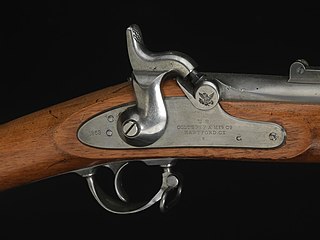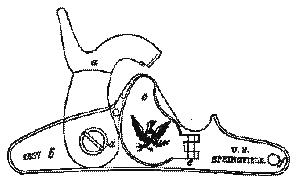
The Charleville musket was a .69 caliber standard French infantry musket used in the 18th and 19th centuries. It was made in 1717 and was last produced during the 1840s. However, it still saw limited use in conflicts through the mid-19th century.
The term Springfield rifle may refer to any one of several types of small arms produced by the Springfield Armory in Springfield, Massachusetts, for the United States armed forces.

The Springfield Model 1861 was a Minié-type rifled musket used by the United States Army during the American Civil War. Commonly referred to as the "Springfield". It was the most widely used Union Army shoulder weapon during the Civil War, favored for its range, accuracy, and reliability.

The Springfield Model 1863 was a .58 caliber rifled musket manufactured by the Springfield Armory and independent contractors between 1863 and 1865.
A rifled musket, rifle musket, or rifle-musket is a type of firearm made in the mid-19th century. Originally the term referred only to muskets that had been produced as a smoothbore weapon and later had their barrels replaced with rifled barrels. The term later included rifles that directly replaced, and were of the same design overall as, a particular model of smoothbore musket.

The musketoon is a shorter-barrelled version of the musket and served in the roles of a shotgun or carbine. Musketoons could be of the same caliber as the issue musket or of a much larger caliber, 1.0–2.5 inches (25–63 mm). The musketoon is most commonly associated with naval use, and pirates in particular, though they also served in a carbine role with cavalry. Musketoon barrels were often flared at the muzzle, resembling a cannon or blunderbuss.

The Springfield Model 1816 was a .69 caliber flintlock musket manufactured in the United States during the early 19th century.

The Springfield Model 1840 was a flintlock musket manufactured by the United States during the mid-19th century. The .69 caliber musket had a 42-inch (107 cm) barrel, an overall length of 58 inches (147 cm), and a weight of 9.8 pounds (4.4 kg). More than 30,000 were produced by the Springfield and Harpers Ferry armories and two independent contractors between 1840 and 1846.

The Springfield Model 1822 was a .69 caliber flintlock musket manufactured by the United States in the early 19th century.
The Springfield Model 1812 Musket is a .69 caliber, flintlock musket manufactured by the Springfield Armory.
The Springfield Model 1795 was a .69 caliber flintlock musket manufactured in the late 18th and early 19th centuries in the United States.

The Springfield Model 1868 was one of the rifles which used the trapdoor breechblock design developed by Erskine S. Allin.
The M1841 Mississippi rifle is a muzzle-loading percussion rifle used in the Mexican–American War and the American Civil War.
During the American Civil War, an assortment of small arms found their way onto the battlefield. Though the muzzleloader percussion cap rifled musket was the most numerous weapon, being standard issue for the Union and Confederate armies, many other firearms, ranging from the single-shot breech-loading Sharps and Burnside rifles to the Spencer and the Henry rifles - two of the world's first repeating rifles - were issued by the hundreds of thousands, mostly by the Union. The Civil War brought many advances in firearms technology, most notably the widespread use of rifled barrels.
The Springfield Model 1835 was a .69 caliber flintlock musket manufactured in the United States during the early 19th century.
The Springfield Model 1847 was a percussion lock musketoon produced by the Springfield Armory in the mid-19th century.
The term Joslyn Rifle refers to a series of rifles produced in the mid-19th century. The term is often used to refer specifically to the Joslyn Model 1861/1862, which was the first mass-produced breech-loading rifle produced at the Springfield Armory.

The US Model 1842 Musket was a .69 caliber musket manufactured and used in the United States during the 19th Century. It is a continuation of the Model 1816 line of muskets but is generally referred to as its own model number rather than just a variant of the Model 1816.

The Springfield Model 1855 was a rifled musket widely used in the American Civil War. It exploited the advantages of the new conical Minié ball, which could be deadly at over 1,000 yards (910 m). It was a standard infantry weapon for Union and Confederates alike, until the Springfield Model 1861 supplanted it, obviating the use of the insufficiently weather resistant Maynard tape primer.









